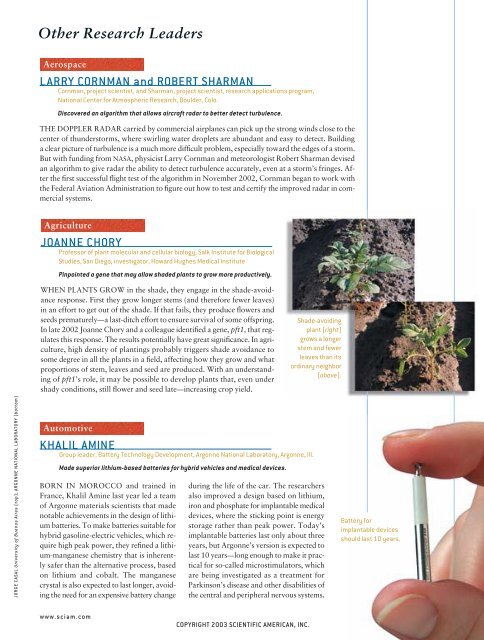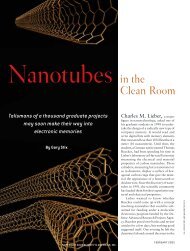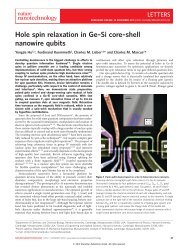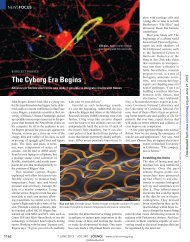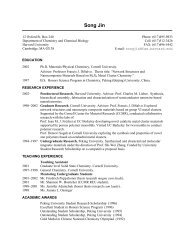download pdf - Lieber Research Group - Harvard University
download pdf - Lieber Research Group - Harvard University
download pdf - Lieber Research Group - Harvard University
You also want an ePaper? Increase the reach of your titles
YUMPU automatically turns print PDFs into web optimized ePapers that Google loves.
Other <strong>Research</strong> Leaders<br />
Aerospace<br />
LARRY CORNMAN and ROBERT SHARMAN<br />
Cornman, project scientist, and Sharman, project scientist, research applications program,<br />
National Center for Atmospheric <strong>Research</strong>, Boulder, Colo.<br />
Discovered an algorithm that allows aircraft radar to better detect turbulence.<br />
THE DOPPLER RADAR carried by commercial airplanes can pick up the strong winds close to the<br />
center of thunderstorms, where swirling water droplets are abundant and easy to detect. Building<br />
a clear picture of turbulence is a much more difficult problem, especially toward the edges of a storm.<br />
But with funding from NASA, physicist Larry Cornman and meteorologist Robert Sharman devised<br />
an algorithm to give radar the ability to detect turbulence accurately, even at a storm’s fringes. After<br />
the first successful flight test of the algorithm in November 2002, Cornman began to work with<br />
the Federal Aviation Administration to figure out how to test and certify the improved radar in commercial<br />
systems.<br />
Agriculture<br />
JOANNE CHORY<br />
Professor of plant molecular and cellular biology, Salk Institute for Biological<br />
Studies, San Diego; investigator, Howard Hughes Medical Institute<br />
Pinpointed a gene that may allow shaded plants to grow more productively.<br />
WHEN PLANTS GROW in the shade, they engage in the shade-avoidance<br />
response. First they grow longer stems (and therefore fewer leaves)<br />
in an effort to get out of the shade. If that fails, they produce flowers and<br />
seeds prematurely—a last-ditch effort to ensure survival of some offspring.<br />
In late 2002 Joanne Chory and a colleague identified a gene, pft1, that regulates<br />
this response. The results potentially have great significance. In agriculture,<br />
high density of plantings probably triggers shade avoidance to<br />
some degree in all the plants in a field, affecting how they grow and what<br />
proportions of stem, leaves and seed are produced. With an understanding<br />
of pft1’s role, it may be possible to develop plants that, even under<br />
shady conditions, still flower and seed late—increasing crop yield.<br />
Shade-avoiding<br />
plant (right)<br />
grows a longer<br />
stem and fewer<br />
leaves than its<br />
ordinary neighbor<br />
(above).<br />
JORGE CASAL <strong>University</strong> of Buenos Aires ( top); ARGONNE NATIONAL LABORATORY (bottom)<br />
Automotive<br />
KHALIL AMINE<br />
<strong>Group</strong> leader, Battery Technology Development, Argonne National Laboratory, Argonne, Ill.<br />
Made superior lithium-based batteries for hybrid vehicles and medical devices.<br />
BORN IN MOROCCO and trained in<br />
France, Khalil Amine last year led a team<br />
of Argonne materials scientists that made<br />
notable achievements in the design of lithium<br />
batteries. To make batteries suitable for<br />
hybrid gasoline-electric vehicles, which require<br />
high peak power, they refined a lithium-manganese<br />
chemistry that is inherently<br />
safer than the alternative process, based<br />
on lithium and cobalt. The manganese<br />
crystal is also expected to last longer, avoiding<br />
the need for an expensive battery change<br />
during the life of the car. The researchers<br />
also improved a design based on lithium,<br />
iron and phosphate for implantable medical<br />
devices, where the sticking point is energy<br />
storage rather than peak power. Today’s<br />
implantable batteries last only about three<br />
years, but Argonne’s version is expected to<br />
last 10 years—long enough to make it practical<br />
for so-called microstimulators, which<br />
are being investigated as a treatment for<br />
Parkinson’s disease and other disabilities of<br />
the central and peripheral nervous systems.<br />
Battery for<br />
implantable devices<br />
should last 10 years.<br />
www.sciam.com<br />
COPYRIGHT 2003 SCIENTIFIC AMERICAN, INC.


